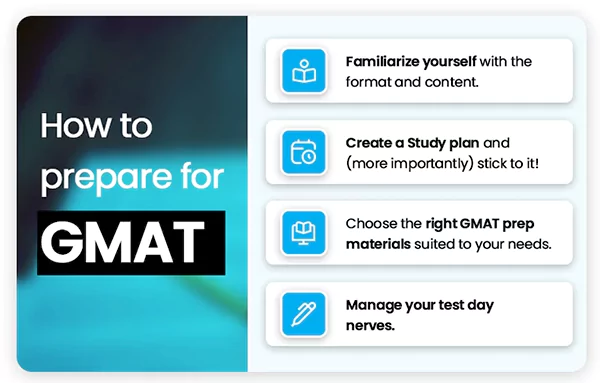Are you gearing up for the GMAT and feeling a bit overwhelmed by the plethora of practice tests available? You’re not alone! In this comprehensive guide, we’ll explore the 14 best GMAT practice tests that will help you achieve the score you need.
From free resources to premium options, we’ve got you covered. Let’s dive into the world of GMAT preparation and unveil the secrets to picking the right practice tests.
Understanding the GMAT Format

Before you start, know what you’re up against.
The Graduate Management Admission Test (GMAT) is a standardized test that evaluates analytical writing, quantitative, verbal, and integrated reasoning skills.
It’s a critical step for admission into business schools globally, and understanding its format is relevant for effective preparation.
1. Sections of the GMAT
- Analytical Writing Assessment (AWA): This section tests your ability to think critically and communicate your ideas. You’ll be asked to analyze an argument and write a critique of that argument.
- Integrated Reasoning (IR): This part assesses your ability to evaluate information presented in multiple formats from multiple sources. It includes graphics interpretation, two-part analysis, table analysis, and multi-source reasoning.
- Quantitative Section: Here, your math skills and understanding of basic concepts of arithmetic, algebra, and geometry are tested. It consists of problem-solving and data-sufficiency questions.
- Verbal Section: This section evaluates your ability to read and understand written material, evaluate arguments, and correct written material to conform to standard written English.
2. Format and Timing
- The Graduation Management Admission Test is a computer-adaptive test (CAT), meaning the difficulty of the questions is adjusted according to your performance.
- Total testing time is about 3.5 hours, including two optional breaks.
- The Analytical Writing Assessment is 30 minutes long, Integrated Reasoning is 30 minutes, the Quantitative section is 62 minutes, and the Verbal section is 65 minutes.
3. Scoring
- The total GMAT score ranges from 200 to 800.
- The Verbal and Quantitative sections contribute to the total score.
- The AWA and IR sections are scored separately and do not contribute to the total score.
4. Preparation Tips
- Understand the format: Familiarize yourself with the types of questions in each section.
- Practice with mock tests: Take full-length practice tests to get used to the timing and format.
- Review basic concepts: Especially for the quantitative section, make sure your fundamental math skills are strong.
5. Importance of the GMAT Format Understanding
- Knowing the sequence helps in strategizing your study plan.
- It allows you to focus on your weak areas, especially if certain sections are more challenging for you.
- Understanding the timing of each section helps in building speed and accuracy.
DO YOU KNOW?
According to GMAC, the owner of the Graduate Management Admission Test, 6,000 programs in some 2,100 universities and institutions use it.
Official GMAT Practice Tests
When preparing for the Graduation Management Admission Test, leveraging official practice tests is necessary.
These exams, designed by the creators of the GMAT, offer the most accurate representation of the actual exam, both in terms of content and sequence. Here’s a detailed look at what they entail:
1. Authenticity and Relevance
- Closest Experience to the Real Test: The official GMAT exercise exams mimic the actual test’s process, question types, and difficulty level. This makes them indispensable for understanding the exam’s structure.
- Up-to-Date Content: These exams include the most recent types of questions and adhere to any changes in the exam pattern.
2. Features of Official GMAT Practice Tests
- Computer-Adaptive Format: Just like the real Graduation Management Admission Test, these exams are computer-adaptive. This means the difficulty level of questions changes based on your answers, offering a realistic test-taking experience.
- Detailed Performance Analysis: After completing an exercise exam, you receive an in-depth analysis of your performance. This includes your score, a breakdown of correct and incorrect answers, and time spent on each question.
3. Number and Availability
The GMAC (Graduate Management Admission Council) typically offers a set of free and additional purchasable practice tests.
- Free Tests: Generally, two free practice papers are available, which can be accessed upon registering on the official GMAT website.
- Purchasable Tests: Additional papers can be purchased, that are useful for extensive practice and repeated assessment.
4. Benefits of Using Official Practice Tests

- Benchmarking Your Performance: By practicing with these papers, you can gauge your readiness for the actual exam. They provide a realistic score range you can expect in the real test.
- Identifying Strengths and Weaknesses: The performance analysis helps you identify areas where you excel and areas that need more focus.
- Strategy Development: Familiarity with the exam system and types of questions aids in developing effective test-taking strategies, such as time management and question tactics.
5. How to Utilize Them Effectively
- Simulate Test Conditions: When practicing with these papers, replicate the actual test conditions as closely as possible, including timing and environment.
- Review and Learn: Don’t just take the exams; spend time reviewing your answers, especially the incorrect ones. Understand why you got a question wrong and learn from your mistakes.
- Regular Practice: Integrate these exams into your regular study plan. Start with taking a test to establish a baseline, and then take subsequent tests to track your progress.
6. Limitations
- Limited Number: Since there’s a finite number of official practice tests, you should use them judiciously.
- May Not Cover All Question Varieties: While comprehensive, they might not encompass every possible question variant you might encounter in the actual exam.
Third-Party Practice Tests
While official Graduation Management Admission Test practices are relevant, third-party ones also play a significant role in your preparation. These exams, offered by various education companies and platforms, provide a different perspective and can complement the official materials effectively.
Here’s a closer look at what third-party GMAT practice tests offer:
1. Variety and Volume
- Diverse Question Bank: Third-party tests often have a vast repository of questions, offering a wide range of scenarios and problem types.
- More Practice Opportunities: Since the number of official practice exams is limited, third-party ones give you more chances to practice and hone your skills.
2. Different Perspectives and Difficulty Levels
- Varied Difficulty: These exams present different levels of difficulty, sometimes more challenging than the official ones, which can be beneficial for high-achieving students.
- Unique Question Styles: Third-party providers often develop their style of questions, which can help expose you to a broader range of question types.
3. Features of Third-Party Practice Tests
- Adaptive Testing: Many top third-party tests mimic the computer-adaptive nature, offering a similar test-taking experience.
- Performance Analysis: Like official exams, most third-party tests provide a detailed analysis of your performance, helping you identify areas for improvement.
4. Advantages of Using Third-Party Tests
- Overcoming Plateaus: If your scores are stagnating with official materials, third-party exams can introduce new challenges and learning opportunities.
- Comprehensive Preparation: Utilizing a mix of official and third-party exams ensures a more rounded preparation, covering a broader spectrum of potential questions.
5. Choosing the Right Third-Party Tests
- Reputation and Reviews: Look for exams from reputable providers with positive reviews from past test-takers.
- Alignment with Official GMAT: Ensure the tests align well with the official format and question types.
6. How to Incorporate Them into Your Study Plan
- Supplement Official Materials: Use third-party tests as a supplement to the official practice materials, not as a replacement.
- Periodic Assessment: Take these exams periodically to assess your progress and identify new areas to focus on.
7. Limitations
- Not Always Representative: Some third-party tests might not accurately reflect the difficulty level or question style of the actual GMAT.
- Quality Variance: The quality of third-party tests can vary significantly, so it’s relevant to pick wisely.
8. Cost Consideration
- Free vs. Paid Options: There are both free and paid third-party exams available. While free ones can be useful for additional practice, paid tests often offer more in-depth analysis and higher-quality questions.
The graph below shows the average number of study hours by GMAT score.

Free vs. Paid Practice Tests
When preparing for the GMAT, one of the pivotal decisions you’ll face is choosing between free and paid exercise exams.
Each type has its own set of benefits and limitations, and understanding these can help you make an informed decision that aligns with your preparation needs and goals.
Free Practice Tests
1. Advantages:
- Cost-Effective: The most apparent advantage is that they are free, making them accessible to everyone regardless of budget.
- Initial Assessment: Free ones are great for gauging your initial skill level and understanding its process.
- Diverse Sources: There are a variety of free exams available from different sources, offering a broad range of questions and difficulty levels.
2. Limitations:
- Quality and Accuracy: The quality and accuracy of these can vary significantly. They may not always align closely with the actual GMAT format and difficulty level.
- Limited Features: They often lack detailed performance analytics and explanations, making it harder to identify and learn from your mistakes.
- Repetitive Questions: Some free tests recycle questions, offering limited value in terms of exposing you to new material.
Paid Practice Tests
1. Advantages:
- Higher Quality and Accuracy: They are generally of higher quality, with questions and sequences closely resembling the actual GMAT.
- In-Depth Analytics: They often come with detailed performance reports, providing insights into your strengths and weaknesses.
- Additional Resources: Many paid tests include extra features like answer explanations, time management tools, and sometimes even access to tutors or interactive learning platforms.
2. Limitations:
- Cost: The most significant limitation is the cost, which can be a barrier for some test-takers.
- Risk of Overinvestment: There’s a risk of investing in expensive resources that may not necessarily guarantee a better score.
- Variability in Value: Not all paid tests offer the same level of quality or value for money, so careful research is required before purchasing.
Making the Choice
- Determine Your Needs: Assess what you need most from a practice test. If you’re just starting, free tests might suffice. If you’re deep into your preparation and need more detailed feedback, consider paid options.
- Budget Consideration: Consider your budget and how much you’re willing to invest in practice materials.
- Mix and Match: Start with free tests for basic practice and move to paid ones for more in-depth preparation as you progress.
- Research and Reviews: Before investing in paid tests, research and read reviews to ensure you’re getting good value for your money.
Online vs. Offline Tests
In the realm of Graduation Management Admission Test preparation, one key decision is when to use online or offline practice exams.
Both processes have distinct characteristics that can impact your study experience and performance.
Understanding these differences will help you opt for the right mix of practice tests for your preparation.
Online Practice Tests
1. Advantages:
- Convenience: They can be taken anywhere with an internet connection, offering flexibility in terms of location and timing.
- Computer-Adaptive Format: Most online exams simulate the computer-adaptive nature of the actual GMAT, providing a more accurate test-taking experience.
- Instant Feedback: They typically provide immediate scoring and feedback, allowing for quick assessment and adjustment of study strategies.
- Interactive Features: They often include interactive elements, such as timed sections, answer explanations, and progress tracking.
2. Limitations:
- Technical Requirements: Reliable internet and a suitable device are necessary, which might be a constraint for some test-takers.
- Distractions: The online environment can be more prone to distractions, especially if testing at home.
- Screen Fatigue: Prolonged screen time can lead to eye strain and fatigue, potentially affecting performance.
Offline Practice Tests
1. Advantages:
- Mimic Real Test Conditions: Taking exams on paper can closely replicate the actual test-taking environment, especially if you’re taking the paper-based GMAT.
- No Technical Dependencies: They eliminate the need for internet access or electronic devices, making them more accessible in certain situations.
- Focus and Concentration: The physical sequence can help some test-takers focus better without the distractions of the online environment.
2. Limitations:
- Lack of Adaptive Nature: Offline exams do not adjust their difficulty based on your answers, unlike the actual computer-adaptive GMAT.
- Delayed Feedback: Scoring and analyzing your performance can take longer since it often requires manual checking.
- Less Interactive: The offline system lacks the interactive elements of online exams, such as immediate scoring and performance tracking.
Additional GMAT Resources
Beyond practice tests, a range of additional resources can significantly enhance your preparation. These resources provide diverse forms of learning and practice, catering to different aspects of the exam.
Here’s an overview of some key supplementary materials you can incorporate into your study plan:
1. GMAT Prep Books
- Comprehensive Guides: Books like the Official Guide for GMAT Review offer a thorough overview of the exam, including practice questions and exams.
- Subject-Specific Books: There are books focused on specific sections, such as quantitative or verbal, which can be invaluable for targeting weaknesses.
2. Online Courses and Tutorials
- Structured Learning: Many online platforms offer structured courses that include video tutorials, practice questions, and full-length exams.
- Flexibility: These courses often allow you to learn at your own pace and on your schedule.
3. Study Apps
- On-the-Go Learning: Apps can provide a convenient way to study anywhere, anytime. They often include practice questions, flashcards, and mini-lessons.
- Interactive Learning: Many apps offer interactive learning experiences, making study sessions more engaging.
4. GMAT Forums and Study Groups
Platforms like GMATClub play a pivotal role in providing a collaborative and resourceful environment for aspirants.
- Peer Learning: Online forums and study groups can be a great way to learn from others’ experiences, ask questions, and share resources.
- Motivation and Support: Being part of a community can provide moral support and motivation throughout your preparation journey.
5. Private Tutoring
- Personalized Attention: A private tutor can provide personalized guidance, focusing specifically on your areas of weakness.
- Strategic Advice: Tutors can offer tailored strategies for tackling the GMAT based on their assessment of your skills and learning style.
6. Workshops and Seminars
- Expert Insights: Workshops and seminars often feature experts who can provide valuable insights into the GMAT, including tips on preparation and test-taking strategies.
- Networking Opportunities: These events can also be a good opportunity to network with other aspirants and professionals.
7. Flashcards
- Memorization Tool: Flashcards are particularly useful for memorizing formulas, vocabulary, and concepts that are significant for the GMAT.
- Self-Testing: They are a great self-testing tool to ensure you retain critical information.
8. Practice Software and Tools
- Simulation Software: Some software tools simulate the actual GMAT test environment, helping you get accustomed to the format and timing.
- Analytical Tools: These tools can analyze your practice test results, providing insights into your performance and areas for improvement.







